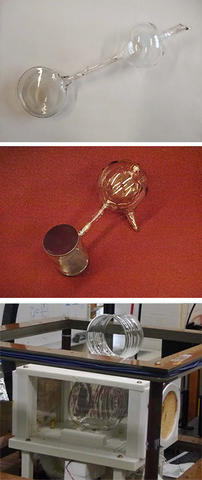Summary
We collaborated on tests at the Insitut Laue Langevin (ILL) to study the effects of high flux neutron beams on spin-exchange optical pumping (SEOP). The key result of this published work was the finding that the alkali spin relaxation induced by the beam, which increases the laser power demand, scales as the square root of the neutron flux.
Description

On the top is shown a small double cell that was tested in the high neutron flux beam at the ILL. The middle photo shows a double cell with a silicon-windowed neutron spin filter cell. The bottom photo shows a large double cell set up for optical pumping tests; the blown cylinder is in the spin-exchange optical pumping oven and flat-windowed neutron spin filter cell is outside the oven.
However, this work opened new questions as the data suggested a possible dependence on the nitrogen pressure in the cells. Nitrogen is required to suppress radiative emission of alkali atoms in SEOP cells. In addition, both fast and slow (~300 s) components of the beam-induced relaxation were observed. In a second set of experiments at the ILL, we collaborated on further investigations. We found that the slow component appears to be associated with nitrogen. However, interpreting the results has proven to be remarkably complicated for several reasons, such as the shortening of stopping lengths for charged particles for higher nitrogen densities. The experiments provided new data, but again opened new questions for further study. The results of these studies have been published in E. Babcock et al, Phys. Rev. A 80, 033414 (2009) and E. Babcock et al, Journal of Physics: Conference Series 294, 012011 (2011).
In parallel, we are developing and testing "double cells," which can potentially bypass this issue by separating the optical pumping volume from the spin filter volume. We tested a small double cell in the high flux ILL beam and the data indicate that it was insensitive to the neutron beam. Such cells have other advantages for continuous pumping and certain cell designs, but also present greater demands on the laser power required for maximum polarization. Various double cells being characterized are shown in the Figure.
Neutron beam effects on SEOP will be understood and addressed, allowing the advantages of 3He spin filters to be exploited for high flux experiments at the NCNR and other US and overseas laboratories. New cell approaches that will be useful for the general goal of continuous optical pumping will be developed.

